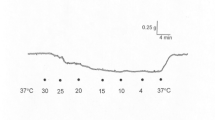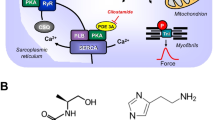Summary
The studies described here show that in isolated vascular rings contractile responses to 5-HT mediated via both 5-HT1-like and 5-HT2 receptors were potentiated by cooling from 37°C to 25°C. This potentiation could be accounted for mainly by an increase in agonist affinity. Antagonist affinity at the two receptor types was unaltered by cooling. These differences in ligand-receptor thermodynamics have clear cut implications for pharmacological receptor classification schemes based upon agonists as well as antagonists. In addition, the results demonstrate that 5-HT1,-like as well as 5-HT2 receptors participate in hypothermia-induced vascular supersensitivity to 5-HT, implying a possible role for either receptor type in cold-induced vasospasm.
Access this chapter
Tax calculation will be finalised at checkout
Purchases are for personal use only
Preview
Unable to display preview. Download preview PDF.
Similar content being viewed by others
References
Arneklo-Nobin, B., Bodelsson, M., Nobin, A., Owman, C., and Tornebrandt, K. (1987). In Nobin, A., Owman, C., and Arneklo-Nobin, B. ( eds. ), Neuronal messengers in vascular function. Elsevier Science Publishers (Biomedical Division), pp. 91–103.
Biondi, M. L., and Marasini, B. (1989). Abnormal platelet aggregation in patients with Raynauds phenomenon. J. Clin. Pathol. 42: 716–718.
Black, J. W., and Leff, P. (1983). Operational models of pharmacological agonism. Proc. R. Soc. Lond. B. 220: 141–162.
Bree, F., El Tayar, N., Van De Waterbeemd, H., Testa, B., and Tillement, J-P. (1986). The binding of agonists and antagonists to rat lung ß-adrenergic receptors as investigated by thermodynamic and structure-activity relationships. J. Receptor Res. 6: 381–409.
Coffman, J. D., Dormandy, J. A., Murray, G. D., Janssens, M. (1990). International study of ketanserin in Raynaud’s phenomenon. In Paoletti, R., Vanhoutte, P. M., Brunello, N., and Maggi, F. M. (eds), Serotonin: from cell biology to pharmacology and therapeutics. Kluwer Academic Publishers, pp 429–433.
Francis, J. L., Roath, O. S., Challenor, V. F., and Waller, D. G. (1988). The effect of nisoldipine on whole blood platelet aggregation in patients with Raynauds phenomenon. Br. J. Clin. Pharmacol. 25: 751–754.
Friedhoff, L. T., Seibold, J. R., Kim, H. C., and Simester, K. S. (1984). Serotonin induced platelet aggregation in systemic sclerosis. Clin. Exp. Rheumatol. 2: 119–123.
Hooker, C. W., Calkins, P. J., and Fleisch, J. H. (1977). On the measurement of vascularand respiratory smooth muscle responses in vitro. Blood Vessels 14: 1–11.
Janssens, W. J., and Vanhoutte, P. M. (1978). Instantaneous changes of alpha-adrenoceptor affinity caused by moderate cooling in canine cutaneous veins. Am. J. Physiol. 234: 330–337.
Kilpatrick, G. J., El Tayar, N., Van De Waterbeemed, H., Jenner, P., Testa, B., and Marsden, C. D. (1986). The thermodynamics of agonist and antagonist binding to dopamine D-2 receptors. Mol. Pharmac. 30: 226–234.
Leff, P., Prentice, D. J., Giles, H., Martin, G. R., and Wood, J. (1990). Estimation of agonist affinity and efficacy by direct, operational model-fitting. J. Pharm. Meths. 23: 225–237.
Marasini, B., Biondi, M. L., Bianchi, E., Dell’Orto, P., and Agostoni, A. (1988). Ketanserin treatment and serotonin in patients with primary and secondary Raynaud’s phenomenon. Eur. J. Clin. Pharmac. 35: 419–421.
Raffa, R. B., Aceto, J. F., and Tallarida, R. J. (1985). Measurement of thermodynamic parameters for norepinephrine contraction of isolated rabbit thoracic aorta. J. Pharmac. Exp. Ther. 235: 596–600.
Reilly, I. A. G., Roy, L., and Fitzgerald, G. A. (1986). Biosynthesis of thromboxane in patients with systemic sclerosis and Raynaud’s phenomenon. B. M. J. 292: 1037–1039.
Stollak, J. S., and Furchgott, R. F. (1983). Use of selective antagonists for determining the type of receptors mediating the action of 5-HT and tryptamine in the isolated rabbit aorta. J. Pharmac. Exp. Ther. 224: 215–221.
Testa, B., Jenner, P., Kilpatrick, G. J., El Tayar. N., Van De Waterbeemd, H., and Marsden, C. D. (1987). Do thermodynamic studies provide information on both the binding to and the activation of dopaminergic and other receptors? Biochem. Pharmac. 36: 4041–4046.
Van Neuten, J. M., DE Ridder, W., and Vanhoutte, P. M. (1984). Ketanserin and vascular contractions in response to cooling. Eur. J. Pharmac. 99: 329–332.
Weiland, G. A., Minneman, K. P., and Molinoff, P. B. (1980). Thermodynamics of agonist and antagonist interactions with mammalian x-adrenergic receptors. Mol. Pharmac. 18: 341–347.
Young, M. S., Iwanov, V., and Moulds, R. F. W. (1986). Interaction between platelet-released serotonin and thromboxane A2 on human digital arteries. Clin. Fxp. Pharm. Physiol. 13: 143–152.
Author information
Authors and Affiliations
Editor information
Editors and Affiliations
Rights and permissions
Copyright information
© 1991 Birkhäuser Verlag Basel/Switzerland
About this chapter
Cite this chapter
Prentice, D.J., Barrett, V.J., MacLennan, S.J., Martin, G.R. (1991). Temperature Dependence of Agonist and Antagonist Affinity Constants at 5-HT1-like and 5-HT2 Receptors. In: Fozard, J.R., Saxena, P.R. (eds) Serotonin: Molecular Biology, Receptors and Functional Effects. Birkhäuser Basel. https://doi.org/10.1007/978-3-0348-7259-1_15
Download citation
DOI: https://doi.org/10.1007/978-3-0348-7259-1_15
Publisher Name: Birkhäuser Basel
Print ISBN: 978-3-0348-7261-4
Online ISBN: 978-3-0348-7259-1
eBook Packages: Springer Book Archive




